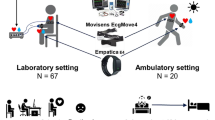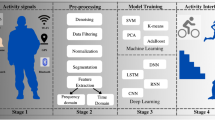Abstract
Biofeedback systems have shown promising clinical results in regulating the autonomic nervous system (ANS) of individuals. However, they typically offer a “one-size-fits-all” solution in which the personalization of the stimuli to the needs and capabilities of its users has been largely neglected. Personalization is paramount in vulnerable populations like children with autism given their sensory diversity. Ambient intelligence (AmI) environments enable creating effective adaptive mechanisms in biofeedback to adjust the stimuli to each user’s performance. Yet, biofeedback models with adaptive mechanisms are scarce in the AmI literature. In this paper, we propose an adaptive model to support biofeedback that takes the user’s physiological data, user’s adherence to therapy, and environmental data to personalize its parameters and stimuli. Based on the proposed model, we present EtherealBreathing, a biofeedback system designed to help children with autism practice box breathing. We used the data from 20 children with autism using EtheralBreating without adaptation mechanisms to feed an adaptive model that automatically adapts the visual and audible stimuli of EtherealBreathing according to changes in each user’s physiological data. We present two scenarios showing how EtherealBreathing is capable of personalizing the stimuli, difficulty level, or supporting the therapist decisions. Results are promising in terms of performance and personalization of each user model, showing the importance of personalization for AmI technology. Finally, we discuss challenges and opportunities in using adaptive models to support biofeedback in AmI environments.










Similar content being viewed by others
References
Ahn Y, Jayalath D, Oloyede A A framework for modularised wearable adaptive biofeedback devices. In: 2016 IEEE 18th International Conference on e-Health Networking, Applications and Services, Healthcom 2016, vol 2016. Institute of Electrical and Electronics Engineers Inc. https://doi.org/10.1109/HealthCom.2016.7749528
Al Osman H, Dong H, El Saddik A (2016) Ubiquitous biofeedback serious game for stress management. IEEE Access 4:1274–1286. https://doi.org/10.1109/ACCESS.2016.2548980
Al Osman H, Eid M, El Saddik A (2014) U-biofeedback: a multimedia-based reference model for ubiquitous biofeedback systems. Multimed Tools Appl 72(3):3143–3168. https://doi.org/10.1007/s11042-013-1590-x
Alhamid MF, Eid M, El Saddik A (2012) A multi-modal intelligent system for biofeedback interactions. In: MeMeA 2012 - 2012 IEEE Symposium on Medical Measurements and Applications, Proceedings, pp 1–5. https://doi.org/10.1109/MeMeA.2012.6226653
Anagnostou E, Taylor MJ (2011) Review of neuroimaging in autism spectrum disorders: what have we learned and where we go from here. https://doi.org/10.1186/2040-2392-2-4
American Psychiatric Association (2013) Diagnostic and statistical manual of mental disorders : DSM-5. American Psychiatric Association
Bal E, Harden E, Lamb D, Van Hecke AV, Denver JW, Porges SW (2010) Emotion recognition in children with autism spectrum disorders: Relations to eye gaze and autonomic state. J Autism Dev Disord 40(3):358–370. https://doi.org/10.1007/s10803-009-0884-3
Bodolai D, Gazdi L, Forstner B, Szegletes L (2015) Supervising biofeedback-based serious games. In: 2015 6th IEEE International Conference on Cognitive Infocommunications (CogInfoCom). IEEE, pp 273–278
Bourg DM, Seemann G (2004) AI for game developers. O’Reilly Media, Inc
Chen Y, Xu W, Sundaram H, Rikakis T, Liu SM (2007) Media adaptation framework in biofeedback system for stroke patient rehabilitation. In: Proceedings of the 15th ACM international conference on Multimedia, pp 47–57
Cheshire WP (2012) Highlights in clinical autonomic neuroscience: New insights into autonomic dysfunction in autism. Autonomic Neuroscience: Basic and Clinical 171(1-2):4–7. https://doi.org/10.1016/j.autneu.2012.08.003
Cook DJ, Song W (2009) Ambient intelligence and wearable computing: sensors on the body, in the home, and beyond. Journal of Ambient Intelligence and Smart Environments 1(2):83–86. https://doi.org/10.3233/AIS-2009-0014
Ducatel K, Bogdanowicz M, Scapolo F, Leijten J, Burgelman JC (2001) SCE-NARIOS FOR AMBIENT INTELLIGENCE IN 2010 Final Report Compiled by. Tech. rep. (2001). URL http://www.cordis.lu/ist/istag.htm
Ebisch SJ, Gallese V, Willems RM, Mantini D, Groen WB, Romani GL, Buitelaar JK, Bekkering H (2011) Altered intrinsic functional connectivity of anterior and posterior insula regions in high-functioning participants with autism spectrum disorder. Hum Brain Mapp 32(7):1013–1028. https://doi.org/10.1002/hbm.21085
Fleury A, Mourcou Q, Franco C, Diot B, Demongeot J, Vuillerme N (2013) Evaluation of a Smartphone-based audio-biofeedback system for improving balance in older adults - A pilot study. In: Proceedings of the Annual International Conference of the IEEE Engineering in Medicine and Biology Society, EMBS, pp 1198–1201. https://doi.org/10.1109/EMBC.2013.6609721
Friedrich EVC, Suttie N, Sivanathan A, Lim T, Louchart S, Pineda JA (2014) Brainˆa computer interface game applications for combined neurofeedback and biofeedback treatment for children on the autism spectrum. Front Neuroeng 7. https://doi.org/10.3389/fneng.2014.00021 URL http://journal.frontiersin.org/article/10.3389/fneng.2014.00021/abstract
Green EE, Green AM, Walters ED (1970) Voluntary control of internal states: psychological and physiological. J Transpersonal Psychol 2(1):1
Harris J, Vance S (2014) Sonic respiration: controlling respiration rate abstract, pp 2383–2388
Jansen LM, Gispen-de Wied CC, van der Gaag RJ, van Engeland H (2003) Differentiation between autism and multiple complex developmental disorder in response to psychosocial stress. Neuropsychopharmacology 28(3):582–590. https://doi.org/10.1038/sj.npp.1300046
Jansen LM, Gispen-De Wied CC, Wiegant VM, Westenberg HG, Lahuis BE, Van Engeland H (2006) Autonomic and neuroendocrine responses to a psychosocial stressor in adults with autistic spectrum disorder. J Autism Dev Disord 36(7):891–899. https://doi.org/10.1007/s10803-006-0124-z
Koegel RL, Wilhelm H (1973) Selective responding to the components of multiple visual cues by autistic children. J Exp Child Psychol 15(3):442–453. https://doi.org/10.1016/0022-0965(73)90094-5
Koenig KP, Buckley-Reen A, Garg S (2012) Efficacy of the get ready to learn yoga program among children with autism spectrum disorders: a pretest-posttest control group design. Am J Occup Ther 66(5):538–546. https://doi.org/10.5014/ajot.2012.004390
Kushki A, Drumm E, Pla Mobarak M, Tanel N, Dupuis A, Chau T, Anagnostou E (2013) Investigating the autonomic nervous system response to anxiety in children with autism spectrum disorders. PLoS ONE 8(4). https://doi.org/10.1371/journal.pone.0059730
Leape C, Fong A, Ratwani RM (2016) Heuristic usability evaluation of wearable mental state monitoring sensors for healthcare environments. In: Proceedings of the human factors and ergonomics society annual meeting, vol 60. SAGE Publications Sage CA, Los Angeles, CA, pp 583–587
Liu H, Hu J, Rauterberg M (2009) Software architecture support for biofeedback based in-flight music systems. In: 2009 2nd IEEE International Conference on Computer Science and Information Technology. IEEE, pp 580–584
Liu NH, Chiang CY, Chu HC (2013) Recognizing the degree of human attention using EEG signals from mobile sensors. Sensors 13(8):10273–10286. https://doi.org/10.3390/s130810273 URL http://www.mdpi.com/1424-8220/13/8/10273
Lovaas OI, Schreibman L (1971) Stimulus overselectiv1ty of autistic children in a two stimulus situation. Behav Res Ther 9(4):305–310. https://doi.org/10.1016/0005-7967(71)90042-8
Lovaas OI, Schreibman L, Koegel R, Rehm R (1971) Selective responding by autistic children to multiple sensory input. J Abnorm Psychol 77(3):211–222. https://doi.org/10.1037/h0031015
Machalicek W, O’Reilly MF, Beretvas N, Sigafoos J, Lancioni GE (2007) A review of interventions to reduce challenging behavior in school settings for students with autism spectrum disorders. Res Autism Spectr Disord 1(3):229–246. https://doi.org/10.1016/j.rasd.2006.10.005
Maclean, D., Roseway, A., Czerwinski, M.: MoodWings: a wearable biofeedback device for real-time stress intervention (2013)
McCuskey M (2000) Fuzzy logic for video games. Game Programming Gems 1:7–8
Ming X, Julu PO, Brimacombe M, Connor S, Daniels ML (2005) Reduced cardiac parasympathetic activity in children with autism. Brain Dev 27(7):509–516. https://doi.org/10.1016/j.braindev.2005.01.003
Mintzberg H (2019) Structured observation as a method to study managerial work. Journal of
Moraveji, N., Olson, B., Nguyen, T., Saadat, M., Khalighi, Y., Pea, R., Heer, J.: Peripheral Paced Respiration: influencing user physiology during information work (2011)
MUKAE, H., SATO, M.: The effect of color temperature of lighting sources on the autonomic nervous functions. Ann Physiol Anthropol 11(5), 533–538 (1992). DOI https://doi.org/10.2114/ahs1983.11.533, URL http://joi.jlc.jst.go.jp/JST.Journalarchive/ahs1983/11.533?from=CrossRef
Murphy CM, Deeley Q, Daly E, Ecker C, O’Brien F, Hallahan B, Loth E, Toal F, Reed S, Hales S, Robertson D, Craig M, Mullins D, Barker G, Lavender T, Johnston P, Murphy K, Murphy D (2012) Anatomy and aging of the amygdala and hippocampus in autism spectrum disorder: an in vivo magnetic resonance imaging study of Asperger syndrome. Autism Res 5(1):3–12. https://doi.org/10.1002/aur.227
Nordahl CW, Scholz R, Yang X, Buonocore MH, Simon T, Rogers S, Amaral DG (2012) Increased rate of amygdala growth in children aged 2 to 4 years with autism spectrum disorders: a longitudinal study. Arch Gen Psychiatry 69(1):53–61. https://doi.org/10.1001/archgenpsychiatry.2011.145
Pantelopoulos A, Bourbakis N (2008) A survey on wearable biosensor systems for health monitoring. In: Proceedings of the 30th Annual International Conference of the IEEE Engineering in Medicine and Biology Society, EMBS’08-“Personalized Healthcare through Technology”, pp 4887–4890. https://doi.org/10.1109/iembs.2008.4650309
Peña O, Cibrian FL, Tentori M (2020) Circus in Motion: a multimodal exergame supporting vestibular therapy for children with autism. J Multimodal User Interfaces. https://doi.org/10.1007/s12193-020-00345-9
Pirovano M (2012) The use of fuzzy logic for artificial intelligence in games. University of Milano, Milano
Prinsloo GE, Derman WE, Lambert MI, Rauch HL (2013) The effect of a single session of short duration biofeedback-induced deep breathing on measures of heart rate variability during laboratory-induced cognitive stress: a pilot study. Appl Psychophysiol Biofeedback 38(2):81–90
Ribeiro AG, Maitelli AL, Valentim RA, Brandão GB, Guerreiro AM (2010) Angelcare mobile system: Homecare patient monitoring using bluetooth and gprs. In: 2010 Annual International Conference of the IEEE Engineering in Medicine and Biology. IEEE, pp 2200–2203
Rodrigue M, Son J, Giesbrecht B, Turk M, Höllerer T (2015) Spatio-temporal detection of divided attention in reading applications using EEG and eye tracking. In: International Conference on Intelligent User Interfaces, Proceedings IUI, vol 2015-January. Association for Computing Machinery, New York, New York, USA, pp 121–125. https://doi.org/10.1145/2678025.2701382 URL http://dl.acm.org/citation.cfm?doid=2678025.2701382
Rogers SJ, Ozonoff S (2005) Annotation: what do we know about sensory dysfunction in autism? A critical review of the empirical evidence. https://doi.org/10.1111/j.1469-7610.2005.01431.x
Schumann CM, Barnes CC, Lord C, Courchesne E (2009) Amygdala enlargement in toddlers with autism related to severity of social and communication impairments. Biol Psychiatry 66(10):942–949. https://doi.org/10.1016/j.biopsych.2009.07.007
Schumann CM, Hamstra J, Goodlin-Jones BL, Lotspeich LJ, Kwon H, Buonocore MH, Lammers CR, Reiss AL, Amaral DG (2004) The amygdala is enlarged in children but not adolescents with autism; the hippocampus is enlarged at all ages. J Neurosci 24(28):6392–6401. https://doi.org/10.1523/JNEUROSCI.1297-04.2004
Shamekhi A, Bickmore T (2018) Breathe deep: a breath-sensitive interactive meditation coach. In: ACM International Conference Proceeding Series. Association for Computing Machinery, New York, NY, USA, pp 108–117. https://doi.org/10.1145/3240925.3240940 URL https://dl.acm.org/doi/10.1145/3240925.3240940
Sharry J, McDermott M, Condron J (2003) Relax to win treating children with anxiety problems with a biofeedback video game. Eisteach 2:22–26
Smeekens I, Didden R, Verhoeven EW (2013) Exploring the relationship of autonomic and endocrine activity with social functioning in adults with autism spectrum disorders. J Autism Dev Disord 45(2):495–505. https://doi.org/10.1007/s10803-013-1947-z
Sugarman LI, Garrison BL, Williford KL (2013) Symptoms as solutions: hypnosis and biofeedback for autonomic regulation in autism spectrum disorders. Am J Clin Hypn 56(2):152–173. https://doi.org/10.1080/00029157.2013.768197
Swanson, K.S., Gevirtz, R.N., Brown, M., Spira, J., Guarneri, E., Stoletniy, L.: The effect of biofeedback on function in patients with heart failure. Appl Psychophysiol Biofeedback 34(2), 71–91 (2009). DOI https://doi.org/10.1007/s10484-009-9077-2 URL http://www.ncbi.nlm.nih.gov/pubmed/19205870
Szabo M, Pomazi KD, Radostyan B, Szegletes L, Forstner B (2017) Estimating task difficulty in educational games. In: 7th IEEE International Conference on Cognitive Infocommunications, CogInfoCom 2016-Proceedings. Institute of Electrical and Electronics Engineers Inc., pp 397–402. https://doi.org/10.1109/CogInfoCom.2016.7804582 URL http://ieeexplore.ieee.org/document/7804582/
Udupa K, Madanmohan, Bhavanani AB, Vijayalakshmi P, Krishna-murthy N (2003) Effect of pranayam training on cardiac function in normal young volunteers. Indian Journal of Physiology and Pharmacology 47(1):27–33 URL http://www.ncbi.nlm.nih.gov/pubmed/12708121
Valenti VE, Guida HL, Frizzo ACF, Cardoso ACV, Vanderlei LCM, de Abreu LC (2012) Auditory stimulation and cardiac autonomic regulation. Clinics 67(8):955–958
Weaver L, Wooden T, Grazer J (2019) Validity of apple watch heart rate sensor compared to polar h10 heart rate monitor [Georgia College and State University]. J Student Res
Yamamoto S, Iwamoto M, Inoue M, Harada N (2007) Evaluation of the effect of heat exposure on the autonomic nervous system by heart rate variability and urinary catecholamines. Journal of Occupational Health 49(3):199–204. https://doi.org/10.1539/joh.49.199
Yu B, Hu J, Funk M, Feijs L (2018) Delight: biofeedback through ambient light for stress intervention and relaxation assistance. Pers Ubiquit Comput 22(4):787–805
Yu B, Hu J, Funk M, Liang RH, Xue M, Feijs L (2018) RESonance: lightweight, room-scale audio-visual biofeedback for immersive relaxation training. IEEE Access 6:38336–38347. https://doi.org/10.1109/ACCESS.2018.2853406 URL https://ieeexplore.ieee.org/document/8404138/
Author information
Authors and Affiliations
Corresponding author
Additional information
Publisher’s note
Springer Nature remains neutral with regard to jurisdictional claims in published maps and institutional affiliations.
Supplementary Information
ESM 1
(PDF 665 kb)
Rights and permissions
About this article
Cite this article
Morales, A., Cibrian, F.L., Castro, L.A. et al. An adaptive model to support biofeedback in AmI environments: a case study in breathing training for autism. Pers Ubiquit Comput 26, 1445–1460 (2022). https://doi.org/10.1007/s00779-020-01512-1
Received:
Accepted:
Published:
Issue Date:
DOI: https://doi.org/10.1007/s00779-020-01512-1




